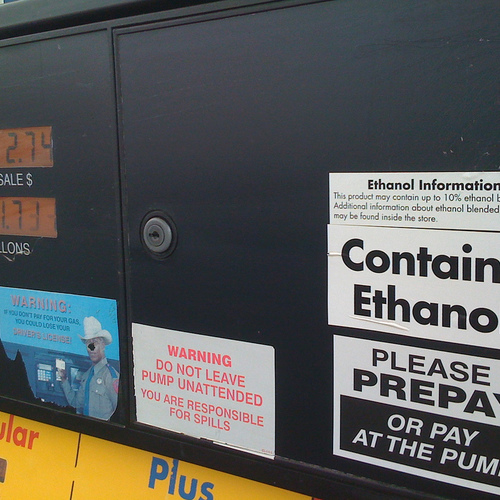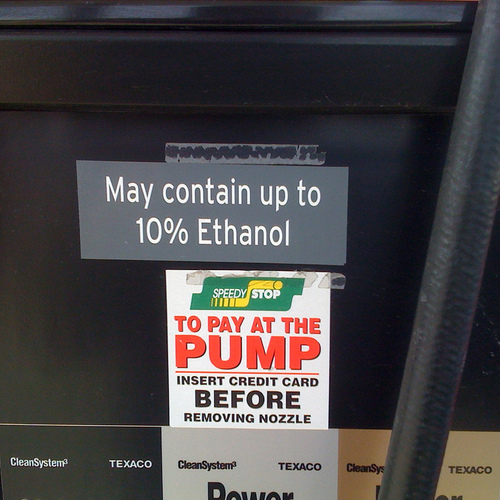
President Donald Trump has promised his supporters in Iowa that the federal government will take a step that may increase corn ethanol sales.
This plant-derived fuel, which comprises about 10% of the 143 billion gallons of gasoline Americans buy each year, is a kind of alcohol made from corn. The industry first emerged in 1980s with government support, after interest in making the country less reliant on imported oil surged in the 1970s. It later acquired a second purpose: lowering greenhouse gas emissions.
I have spent the last 24 years studying alternative fuels and fuel blends. Based on my research, and as a consumer, I can say that increasing the amount of ethanol blended with gasoline creates problems with older engines and potentially increases air pollution due to increased fuel evaporation while doing little to curb climate change.
E10 and E15
Americans have been mixing ethanol and gasoline since Henry Ford touted the potential of biofuels. His Model T could run on gasoline or ethanol or a combination.
But ethanol use only took off in the 1970s following the energy crisis. Its use expanded greatly during George W. Bush’s administration, with the advent of the Renewable Fuel Standard in 2005. This federal program mandated that increasing amounts of renewable fuels be mixed with gasoline and diesel. The program has set a target for the domestic consumption of 15 billion gallons of corn ethanol since 2015.
Most engines can safely run on a blend of 90% gasoline and 10% corn ethanol, the standard formulation known as E10 that is available at most American gas stations. E15 is a blend containing 15% ethanol. This blend is not available in every state.
And where E15 is sold, it isn’t currently available year-round.
That’s because the additional 5% of ethanol, combined with summer heat, would increase the tendency of blended fuels to evaporate. The evaporated emissions from fuels can contribute to the formation of ozone, a major component of smog. In hotter weather, ethanol can exacerbate pollution problems in cities. Trump’s proposal would eliminate the existing summer ban on E15 sales.
Winners and losers
Removing the ban would probably boost ethanol sales, aiding farmers who grow the corn used to make the roughly 16 billion gallons of it the U.S. produced in 2017, including exports, and the ethanol industry overall.
Because a higher percentage of ethanol means a lower percentage of petroleum, using more ethanol hurts petroleum refiners. It would also pose a logistical challenge. Ethanol cannot go into oil or gas pipelines because it absorbs excess water and impurities within pipelines. That means rail cars and tanker trucks transport all ethanol.
Although ethanol proponents say its use cuts carbon emissions, the evidence is mixed.
The government has determined that corn ethanol is much less effective than other biofuels at reducing carbon emissions, producing only 1.5 to 2.1 units of energy for every unit used to produce it. This is much less efficient than biodiesel made from soybean oil, which produces 5.5 units of renewable energy for every unit consumed in production.
The ethanol Brazilians make from sugarcane residues does a much better job of shrinking that country’s carbon footprint. Converting sugarcane wastes into ethanol produces more than 9.4 units of energy for every unit that producing this fuel consumes.
Flawed arguments
One of the original goals behind mandating ethanol blends was to reduce oil imports. While corn ethanol does directly displace gasoline consumption, other efforts to reduce oil imports have had far more impact.
The share of oil the U.S. imports has fallen in recent years, but that decline is largely due to a domestic production boom brought on by hydraulic fracturing (often called fracking), horizontal drilling and other technological advances. Increased domestic output has displaced 54.5 billion gallons of imported oil annually – more than three times the roughly 15 billion gallons of oil per year ethanol is displacing.
Biodiesel and renewable diesel, made from vegetable oils and animal fats, are displacing another nearly 3 billion gallons of diesel derived from petroleum per year.
A TV commercial I’ve seen during football games touted two other flawed arguments in favor of increasing corn ethanol production: that E15 will mean “cleaner air” at a “lower cost.”
The problem is that blending ethanol with other fuels lowers their energy content, slightly decreasing fuel economy. It may cost a bit less to fill up your tank but based on my calculations the decrease in miles per gallon that E15 would yield will mean it makes no difference on your wallet.
Likewise, the claim that E15 leads to cleaner air is not justifiable.
For one thing, all vehicles made since 1975 have catalytic converters that remove unburned hydrocarbons and other airborne pollutants. For another, the Energy Department has not detected any across-the-board reduction in tailpipe emissions associated with ethanol use. Instead, it has observed that using more ethanol may slightly increase the tailpipe emissions of aldehydes, which are respiratory irritants.
Old cars and chainsaws
All cars since model year 2001 can operate safely on E15, but not older cars. Vehicles manufactured before 2001 could suffer fuel system or engine damage if they’re run on E15. The government requires the labeling of all E15 fuel pumps to prevent accidental use for this reason.
A bipartisan bill is pending in Congress that would take this notification further by making the labels bigger and mandating that they warn consumers to check their owners’ manuals.
Another problem is that concentrations of ethanol in excess of 10% can hurt non-automotive engines, the Energy Department has found. These include, for example, the motors in lawn and garden equipment, motorcycles and speedboats.
Smaller engines lack computer controls able to adjust to operation on ethanol blends. If, say, the chain on your chainsaw engages without you intending it to, you could be in real danger. This malfunctioning can potentially cause accidents in which people lose fingers or even limbs.
Even once manufacturers redesign their weed-whacker and chainsaw engines to become compatible with higher ethanol blends, consumers who own older equipment would remain at risk of having them break down due to changes in fuel composition if E15 becomes the norm at filling stations.
People who own lawn and garden equipment and speedboats would have to go out of their way to avoid this problem by buying “pure gasoline.”
In short, year-round sales of E15 probably aren’t going to do much to reduce oil imports or trim the nation’s carbon footprint. It would take more ambitious and strategic energy policies to achieve those worthwhile goals.
André Boehman is a professor of mechanical engineering and director of the W.E. Lay Automotive Laboratory at the University of Michigan. This post originally appeared at The Conversation.
Weekly Newsletter
Get building science and energy efficiency advice, plus special offers, in your inbox.















10 Comments
The real story is the farmers want to keep their profit stream intact and expand it.
Once we start transitioning to EVs en masse this scheme will collapse but until then we are stuck with this fools gold.
My experience is that even E10 isn't safe in some old equipment. Wikipedia says E5 or E7 are generally safe, and that sounds more likely.
Within 10 years (maybe 5) almost all cars and light trucks sold in the US will be plug-in, either battery only or hybrid, and the internal combustion engines in the hybrids will be ethanol tolerant, but the total volume of liquid automotive fuels sold in the US is poised for a huge, rapid drop over the next decade.
Going with higher ethanol blends now will accelerate the retirement of older cars. While this could be something of a "taking" for those who don't read the labels or understand the issue, the vehicles that replace them will be less damaging to the environment overall.
My brother only uses aviation fuel in his competition dirt bikes- much nicer to the equipment than anything available at the local gas station.
For anyone running an ethanol sensitive engine under normal conditions, I'd use ethanol free "rec gas" over 100LL av gas - lead is bad for people and bad for an engine.
I hope its 5-10 years but i don't think Tesla will be able to build 100 million cars a year by then and the legacy players still seem to think that denial will keep their gravy train going.
Now i hope i am wrong, Tesla will expand greatly and the lumbering dinosaurs are gonna have their lunches eaten with the Model Y and pickup.
Tesla who? It's not about Tesla.
Denial?
That may have been true a dozen years ago, but this train has already left the station and is picking up speed, and ALL automakers understand the existential threat!
Just this month General Motors announced the closing of auto plants and discontinuing most of their sedans (including the hybrid Volt) with the express purpose of focusing on developing their battery EV lineup.
https://www.mprnews.org/story/2018/12/06/what-do-the-big-general-motors-plant-closures-mean-for-electric-cars-
By 2030 it will be illegal to sell internal combustion engine (ICE) cars in Ireland, Denmark, India (big potential growth market), the Netherlands, and Israel. Before then, in 2020 South Korea (a large auto export country) will disallow the sale of new ICE cars, in 2021 Costa Rica follows suit, and in 2025 Norway. China (big growth market, with several EV manufacturers), Taiwan, Spain, and France will have sales bans, but the market will have already shifted by that late date. It's already cheaper on a lifecycle basis to drive a battery-EV than even the most efficient ICE cars. Before 2025 even the purchase price of an EV will have reach parity with an equivalent ICE car, with higher reliability and lower maintenance costs going forward.
Anyone making their living off fuel ethanol or crude oil is in for a pretty rough ride over the next decade. The tsunami starts with a thin wedge, but rises increasingly rapidly!
The GM announcement was likely more about scapegoating EVs. It didn't work. The Bolt has sold poorly despite their first mover advantage, you could get 5-10K discounts in Cali. And stupidly enough they refused to sell enough to meet demand elsewhere. And they said they planned to accelerate production, their acceleration is pathetic (double entendre).
They also discontinued the Volt, which is actually not a bad thing in the grand scheme. PHEVs are a dead duck. ICE is dead man walking. They should have kept the Volt another 5 years.
But battery supply is gong to hit the legacy players like a ton of bricks. They have very little lined up.
Lets not forget that everyone except Tesla put their might towards watering down China's EV mandate, VW is crying about how Germany's mandate cannot be met and are trying to squash it or at least water it down, their planned 250K EVs won't be enough to meet any targets, and so on. And i always remember Fiat's CEO begging customers to not buy his EVs. What kind of moron does that?
It is very likely one or more of the legacy players will go out of business, Honda and Toyota are still obsessed with fool cells, Ford had its head so far up its rear end they could win the Olympics if such a category existed and many of the others are making pathetic half gestures.
Ironically this is an opening for Chinese EVs and for Tesla. The Model 3 is the 5th top selling car in America and the top highest grossing model in America (thanks to its high purchase price).
All that said we agree on one thing, ICE is going to die very quickly, Fast charging, home charging and 250+mile EVs will destroy ICE and as soon as more models become available and especially pickups Detroit is gonna suffer.
I also agree that life cycle they already destroy gas, and the million mile Tesla motor will be great, the weak spot will be the body in road salt zones. But the purchase price approaching ICE and an oil price shock will be great motivators. Sales are as more about purchase price and sentiment then they are about life cycle costs. Commercial is the opposite, a low life cycle cost will beat all other factors.
The legacy players better get their heads out of their asses soon or they are in for a world of hurt. Gaslighting, lying and strong arming world leaders won't save their hides.
I was interested to see that Norway is finally seeing oil demand drop, down something like 3% last year thanks to their incentives leading to high uptake
Multiple battery mega-factories are currently under construction in Europe, China, and Korea. It's a race to see who can get there fastest with the mostest. It's not clear that battery supply is going to be a problem, unless some of these players are so far ahead of the market that they go bust before the EV market really mushrooms. I'm sure some of the legacy players will fail, but I'm just as sure that many will survive.
Former GM CEO Rick Wagoner is now on the board of directors at the EV charging company ChargePoint.
30% of all cars sold in Norway this year were battery EVs, outpacing the sales of plug-in hybrids, which only accounted for 19% of all sales. OK, that's less than 50% (barely), but it's still 2018, seven years ahead of the ICE ban, and batteries are still on a double-digit percentage learning curve. EV sales in Norway 2008 had less of a market share there than EVs in the US had in 2018- a lot can happen in 10 years (or even 5.) When EVs with 300 miles of range reach cost parity with an ICE equivalent the market cork will have left the neck of the champagne bottle, and it's almost certain to happen before 2028.
The Chinese EV company BYD is planning on building factories in both Mexico and Canada for battery EV trucks and cars. Some of those plans are being held off by the current trade war posturing in the US, but there's no reason to believe they won't be building cars on this continent in under 10 years. They won't be the only new kid on the block either.
Engine damage for using E15 is a bit of a spurious claim, especially after singling out fuel system damage.
While the NREL report did show an increase some emissions it failed to show actual engine harm. Yes, increased emissions points to more possible carbon build-up which can result in engine harm, but this isn't always the case.
While catalytic converters do remove unburned hydrocarbons, they do no remove all of them it would be better to say they are reduced.
The link to the study on the pubmed website is about increased emissions from using ethanol in gasoline on small engines tuned for gasoline not for accidental injuries caused by using ethanol in them. Also accidental engagement of a chain on a chain saw is either equipment malfunction or operator error, neither of which can be definitively linked to ethanol in the gasoline. The real danger with chain saws is that due to the reduced power output of the engine the chain may bind easier and due to operator error may cause the operator to get injured getting the saw unstuck.
Computer controls are entirely unnecessary to correctly tune engines to use Ethanol blended gasoline. Once the fuel system (including the carburetor) is made ethanol safe it is just engine tuning which any small engine shop is able to do. I would also argue the increasing ethanol content in gasoline reduces fuel variability , though I will admit that point is arguable as it also allows lower quality base stocks to be used to make gasoline.
Also non-automotive use people already go out of their way to buy "pure" gasoline. Increasing the Ethanol content is not likely to increase this.
To be clear like the article's author I am not in favor of raising the ethanol percentage in gasoline, at least until we have a better way of producing it. And that should be judged on total energy, total pollutants and total greenhouse gas emissions.
I've had to replace fuel system parts on 3 engines due to ethanol (E10) damage.
Log in or create an account to post a comment.
Sign up Log in